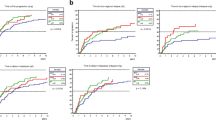Abstract
Purpose
The interaction between interferon treatment and BRAF mutation status among melanoma patients have yet to be evaluated. The present study aims to assess the intermediate dose interferon (IDI) in stage III melanoma patients with respect to BRAF mutation status.
Methods
A total of 46 adult lymph node-positive primary skin melanoma patients (23 BRAF-mutant and 23 BRAF-wild) with available information on the mutational status of the oncogene BRAF V600E were included in the analysis. BRAF V600E mutation was detected using the real-time PCR in the formalin-fixed paraffin-embedded samples. All the patients were treated with adjuvant IDI. IFN-alpha-2b was administered 10 MU per day, subcutaneously, three times per week for 1 year.
Results
The distribution of patient numbers between the clinicopathological variables and BRAF mutation status was well balanced. Most of the patients relapsed (83%); however, no significant differences were found between recurrence frequencies and recurrence sites in accordance with BRAF mutation status. BRAF-mutant melanomas were found to be significantly advantageous in disease-free survival (HR 0.464, p = 0.03). More deaths occurred in BRAF-wild-type patients (67%) (p = 0.03), and BRAF mutation was found to be a favorable prognostic factor for overall survival (HR 0.373, p = 0.04).
Conclusion
The presence of BRAF mutation in stage III melanoma patients treated with IDI might contribute a favorable effect on both disease-free survival and overall survival.


Similar content being viewed by others
References
Siegel RL, Miller KD, Jemal A (2017) Cancer statistics, 2017. CA Cancer J Clin 67:7–30
Balch CM, Soong SJ, Gershenwald JE, Thompson JF, Reintgen DS, Cascinell N et al (2001) Prognostic factors analysis of 17,600 melanoma patients: validation of the American Joint Committee on Cancer Melanoma Staging System. J Clin Oncol 19:3622–3634
Balch CM, Gershenwald JE, Soong SJ, Thompson JF, Atkins MB, Byrd DR et al (2009) Final version of 2009 AJCC melanoma staging and classification. J Clin Oncol 27:6199–6206
Hauschild A. Adjuvant melanoma therapy: European perspective. https://rvmais.com.br/simposiomelanoma/aulas/26/1630-1700-Axel%20Hauschild.pdf. Accessed 2 Mar 2019
NCCN Clinical Practice Guidelines in Oncology (NCCN Guidelines). Cutaneous melanoma. Version 1.2019-November 1, 2018
Tas F, Kurul S, Camlica H, Topuz E (2006) Intermediate dose interferon alpha in adjuvant treatment for high risk melanoma: a single institution’s experience. Med Oncol 23:471–478
Bhatia P, Friedlander P, Zakaria EA, Kandil E (2015) Impact of BRAF mutation status in the prognosis of cutaneous melanoma: an area of ongoing research. Ann Transl Med 3:24
Heppt MV, Siepmann T, Engel J, Schubert-Fritschle G, Eckel R, Mirlach L et al (2017) Prognostic significance of BRAF and NRAS mutations in melanoma: a German study from routine care. BMC Cancer 17:536
Picard M, Dang NP, D’Incan M, Mansard S, Dechelotte P, Pereira B et al (2014) Is BRAF a prognostic factor in stage III skin melanoma? A retrospective study of 72 patients after positive sentinel lymph node dissection. Br J Dermatol 171:108–114
Meckbach D, Bauer J, Pflugfelder A, Meier F, Busch C, Eigentler TK et al (2014) Survival according to BRAF-V600 tumor mutation—an analysis of 437 patients with primary melanoma. PloS One 9:e86194
Sabbatino F, Wang Y, Scognamiglio G, Favoino E, Feldman SA, Villani V et al (2016) Antitumor activity of BRAF inhibitor and IFNα combination 1 in BRAF mutant melanoma. J Natl Cancer Inst 108:djv435
Davar D, Fuchs SY, Kirkwood JM (2016) BRAF inhibitors and IFNα: plus, minus, or indeterminate? J Natl Cancer Inst 108:djv432
Kimbrell HZ, Sholl AB, Ratnayaka S, Japa S, Lacey M, Carpio G et al (2015) BRAF testing in multifocal papillary thyroid carcinoma. Biomed Res Int 2015:486391
Wang X, Mao LL, Si L, Chi Z, Cui C, Sheng XN (2015) Efficacy of high-dose adjuvant interferon therapy in high-risk melanoma harboring gene mutations. J Clin Oncol 33(Suppl):abstr 9047
Wang W, Edington HD, Rao UN, Jukic DM, Land SR, Ferrone S et al (2007) Modulation of signal transducers and activators of transcription 1 and 3 signaling in melanoma by high-dose IFNalpha2b. Clin Cancer Res 13:1523–1531
Acknowledgements
We thank Prof. Ugur Gezer for valuable contribution in the preparation of the manuscript.
Funding
None.
Author information
Authors and Affiliations
Corresponding author
Ethics declarations
Conflict of interest
The authors declare that they have no conflicts of interest.
Informed consent
Informed consent was obtained from all individual participants included in the study. The study was reviewed and approved by our local ethical committee.
Ethical approval
All the procedures performed in studies involving human participants were in accordance with the ethical standards of the institutional and/or national research committee and with the 1964 Helsinki Declaration and its later amendments or comparable ethical standards.
Additional information
Publisher's Note
Springer Nature remains neutral with regard to jurisdictional claims in published maps and institutional affiliations.
Rights and permissions
About this article
Cite this article
Tas, F., Erturk, K. BRAF mutation status might contribute an effect on both disease-free and overall survival in stage III cutaneous melanomas treated with intermediate dose interferon-alpha. Cancer Chemother Pharmacol 84, 521–526 (2019). https://doi.org/10.1007/s00280-019-03842-1
Received:
Accepted:
Published:
Issue Date:
DOI: https://doi.org/10.1007/s00280-019-03842-1




